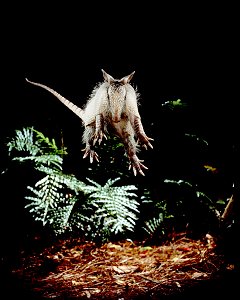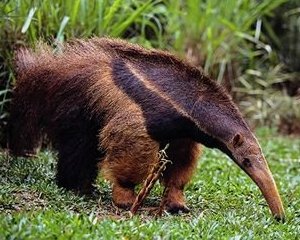THE ORDER XENARTHRA
Xenarthra – Strange Jointed Mammals (About 30 species)
Southern North America and South America is their distribution, and the Xenarthrans consist of 29 species in four distinct families: anteaters, sloths (two families – two and three-toed), and armadillos. Anteaters are toothless, sloths and armadillos lack incisors and canines but do have simple cheek teeth that lack enamel and grow continuously from the roots as the tops wear down. Armadillos have up to 100 such teeth.

Their skulls are elongated and the brain small and narrow. But other similarities seem difficult to come by. How could three such different-looking types of animals be related? It is in the vertebrae of the lumbar region where they have an extra articulation. It is a skeletal feature peculiar to this order, and “Xenarthra” means “strange joints.”
Their specially strengthened backbone may have evolved from the defense posture that anteaters assume. If threatened, the animal stands erect on its hind legs and braces itself with its strong, heavy tail, forming a tripod. It then proceeds to lash out with its powerful arms, slashing with its formidable claws.
Giant ancestors of today’s anteaters may have defended themselves in this manner against such attackers as sabertooth cats. The Xenarthrans that we know in present times are but a remnant of their Cenozoic past. While in Argentina, in 1833, on the famous voyage of the Beagle, Darwin collected fossils of one of the most fantastic mammals ever to live, the glyptodont.

Glyptodonts were ancient armadillos, but of giant proportions almost 12 feet long. Like today’s armadillos, they were completely armored, having a bony helmet on the head, a great bony mosaic covering the back and sides of the body, and a jointed armor plate over the tail, terminating in a defensive, multi spiked club. They once roamed the region from Florida to Arizona and down into Central and South America.
The giant ground sloth, as big as a rhinoceros, lived throughout the Americas and was another of the fossil Xenarthrans that Darwin picked up in South America. Ground sloths became extinct near the end of the Pleistocene, only about 10,000 years ago, and would have been known to early man in the Americas.

Today, except for the armadillos, xenarthrans are tropical dwellers, found in Central and South America. The nine-banded armadillo ranges into the southwestern United States, and other armadillo species live in temperate, even near-desert, regions in South America. Like their ancestors, though perhaps less extreme, armadillos are armored with jointed, bony plates covered with a cornified epidermis. Sparse hair grows between the plates and on unarmored parts of the body and limbs.
Anteaters and sloths are well furred, without armor.
Check out the following specific Xenarthrans include:
Giant Anteater
Tamandua
Three-Toed Sloth
Two-Toed Sloth
Common Armadillo
Hairy Armadillo
